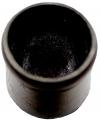

2. Page Marker
4. Seals
5. Rowels
8. Tweezers
9. Pricker
10. Leads
11. Quill Pens
12. Four-flanged Pen
13. Stylus
14. Penners
15. Firelighter Iron
16. Tooth Burnisher
17. Medieval Inks
18. Lead Inkwell
19. Inkhorn
Title Medieval Inks

Brief description There were two distinct types of ink: carbon ink and metal–gall ink. Carbon inks, sometimes called Indian inks, were prepared by mixing soot or lamp black with a dried tree sap, commonly gum arabic, and water. These inks were used in the ancient worlds (Egyptian, Greek, Roman), and in Medieval manuscripts until the twelfth century. The transition to metal–gall inks was gradual, beginning in the seventh century. Their use dominated the Medieval period. The tannins in iron-gall inks make them acidic and the ink actually bites into the parchment, which makes them durable, but sometimes the ink is so acidic it continues to eat through the parchment causing holes to form when stored improperly. Palatino's Recipe, 1540 “Soak 3 oz galls coarsely crushed in 1 5/8 pints rainwater. Leave in the sun 1 or 2 days. Add 2 oz copperas, finely crushed, stir well with a fig stick. Leave in the sun 1 or 2 days. Add 1 oz gum arabic, and leave one day in the sun.” The earliest reference to metal–gall ink is made by the monk Theophilus in the eleventh century. The ink is made from oak galls, also called oak apples or gallnuts: ball-like tumors found on the leaves and twigs of oak trees. They are formed by the gall wasp, which lays its egg in a bud of the tree causing a marble–sized ball to grow around the developing young. These balls were crushed and soaked in rainwater, wine, or vinegar, then dried to produce a powder that was mixed with green vitriol. Green vitriol, or iron sulphate, was produced by the evaporation of water from ferrous soils. The two ingredients were stirred and gum arabic added as a thickener. Iron–gall ink darkens when exposed to air, and soaks well into parchment, as opposed to carbon inks which can rub off easily. Red Ink was also used extensively in the Medieval period for titles, initials, and headings. It was made from vermillion, a compound of mercury and sulphur, which was mixed with egg white and gum arabic. It was also made from brazilwood chips infused with vinegar and mixed with gum arabic. Another Red Ink Recipe: [From A Booke of Secrets: Shewing diuers ways to make and prepare all sorts of Inke, and Colours: as Black, White, Blew, Greene, Red, Yellow, and other Colours. Also to write with Gold and Silver, or any kind of Mettall out of the Pen; with many other profitable secrets as to colour Quils and Parchment of any colour: and to graue with Dtrong Water in Steele and Iron. Necessarie to be knowne of all Scriueners, Painters and others that delight in such Arts. Translated out of the Dutch into English, by W.P., London, 1596. (Medieval Manuscripts: Some Ink and Pigment Recipes)] “To seeth Brasill in another way. To an ounce of Brasill, take the third part of a quart of beere, wine or vinegar, put it in a new pot let it stand a night, in the morning set it on fire and let it seeth till it be halfe consumed, then for euery ounce of Brasill, take two pennyworth of alum, beaten to a pouder, and as much beaten gum Arabike, stir them wel together, and let them seeth againe, but if you desire to have it somewhat dark, then scrape a little chalke into it: when it seetheth, let it not seeth over the pot, and being cold, strain it through a cloath, and put it into a glasse well stopped." [Probably NOT for presentation] Brazil wood is from an East Indian tree known for its reddish color. Blue was the most highly prized pigment by Medieval scribes, being the color of the Virgin Mary’s robe, and the celestial firmament. It was made from genuine ultramarine or azurite. Genuine ultramarine was produced by grinding and purifying lapis lazuli, a semi-precious stone that had to be imported from Persia. Indigo was also sometimes used. Green was made from malachite, combined with water, gum arabic, and egg white. A recipe from the 11th or 10th century (from Medieval Manuscripts Booklet) provides these instructions: “Take ripe seeds of the shrub caprifolium, that is in English gatetriu [honeysuckle], and grind them together well in a mortar; afterwards, let them boil thoroughly in wine, at the same time adding to the concoction iron that has rusted. This is a brilliant green ink. [add copperas or ferrous sulfide to make it black] verdigris-copper disolved in strong vinegar. Purple was made by combining red and blue or from brazil wood, haematite, and even whelks.” Baranov, Vladimir. Materials and Techniques of Manuscript Production. (2013) Medieval Manuscript Manual. Retrieved March 3, 2014 from http://web.ceu.hu/medstud/manual/MMM/. Web Medieval Ink. (2003) History.UK.com. Retrieved March 3, 2014 from http://www.history.uk.com/calligraphy/medieval-ink-there-were-two-very-di/ Fisher, M. Therese. “Ink.” The Calligrapher’s Handbook. Ed Heather Child. London: A&C Black. 1985. 38-44. Print. Hutton, Dorothy. “Pigments and Media.” The Calligrapher’s Handbook. Ed. Heather Child. London: A&C Black. 1985. 45-58. Print. Mazzarino, Sara. Report on the different inks used in Codex Sinaiticus and assessment of their condition. (2013). Codex Sinaiticus. Retrieved March 5, 2014 from http://codexsinaiticus.org/en/project/conservation_ink.aspx Medieval Manuscripts: Some Ink and Pigment Recipes. (2012) Traveling Scriptorium. Ed. Special Collections Conservation Unit of the Preservation Department of Yale University. Retrieved March 9, 2014 from http://travelingscriptorium.files.wordpress.com/2012/03/scopa-recipes booklet_web.pdf
Contributor: Sean Gates
Contribution date: Winter 2014